- Home
- About
- Map
- Trips
- Bringing Boat West
- Migration West
- Solo Motorcycle Ride
- Final Family XC Trip
- Colorado Rockies
- Graduates' XC Trip
- Yosemite & Nevada
- Colorado & Utah
- Best of Utah
- Southern Loop
- Pacific Northwest
- Northern Loop
- Los Angeles to NYC
- East Coast Trips
- Martha's Vineyard
- 1 Week in Quebec
- Southeast Coast
- NH Backpacking
- Martha's Vineyard
- Canadian Maritimes
- Ocracoke Island
- Edisto Island
- First Landing '02
- Hunting Island '02
- Stowe in Winter
- Hunting Island '01
- Lake Placid
- Chesapeake
- Provincetown
- Hunting Island '00
- Acadia in Winter
- Boston Suburbs
- Niagara Falls
- First Landing '99
- Cape Hatteras
- West Coast Trips
- Burning Man
- Utah Off-Roading
- Maui
- Mojave 4WD Course
- Colorado River Rafting
- Bishop & Death Valley
- Kauai
- Yosemite Fall
- Utah Off-Road
- Lost Coast
- Yosemite Valley
- Arizona and New Mexico
- Pescadero & Capitola
- Bishop & Death Valley
- San Diego, Anza Borrego, Joshua Tree
- Carmel
- Death Valley in Fall
- Yosemite in the Fall
- Pacific Northwest
- Utah Off-Roading
- Southern CA Deserts
- Yosemite & Covid
- Lake Powell Covid
- Eastern Sierra & Covid
- Bishop & Death Valley
- Central & SE Oregon
- Mojave Road
- Eastern Sierra
- Trinity Alps
- Tuolumne Meadows
- Lake Powell Boating
- Eastern Sierra
- Yosemite Winter
- Hawaii
- 4WD Eastern Sierra
- 4WD Death Valley +
- Southern CA Deserts
- Christmas in Tahoe
- Yosemite & Pinnacles
- Totality
- Yosemite & Sierra
- Yosemite Christmas
- Yosemite, San Diego
- Yosemite & North CA
- Seattle to Sierra
- Southwest Deserts
- Yosemite & Sierra
- Pacific Northwest
- Yosemite & South CA
- Pacific Northwest
- Northern California
- Southern Alaska
- Vancouver Island
- International Trips
- Index
- Tips
- Books
- Photos/Videos
- Search
- Contact
Crater Lake National Park, OR
Friday, September 13, 2019 - 4:00pm by Lolo
260 miles and 6 hours from our last stop - 1 night stay
Travelogue
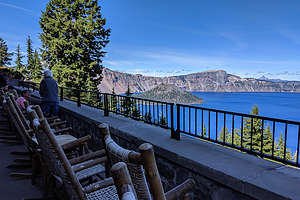 Porch of Crater Lake LodgeOne of the ways Herb had enticed me into the idea of spending 6 nights sleeping in the back of a truck in some of the most remote and desolate parts of Oregon was to suggest that we could see a play at the Oregon Shakespeare Festival in Ashland afterwards. I’ve always been a sucker for Shakespeare and in my early adulthood I read all of his plays and several biographies, so I bit.
Porch of Crater Lake LodgeOne of the ways Herb had enticed me into the idea of spending 6 nights sleeping in the back of a truck in some of the most remote and desolate parts of Oregon was to suggest that we could see a play at the Oregon Shakespeare Festival in Ashland afterwards. I’ve always been a sucker for Shakespeare and in my early adulthood I read all of his plays and several biographies, so I bit.
I was able to secure two tickets for the Saturday night performance of Macbeth, which gave us one more day to fill before arriving in Ashland. A brief look at the map revealed an excellent enroute choice - Crater Lake National Park, a park we had been to twice in the past, but was definitely worthy of a third visit, especially when that visit corresponded with a full moon.
Getting a campsite at Crater Lake on a Friday night wasn’t exactly a given, but we lucked out and got the very last reservable site. I felt a little guilty taking it, because it was a 50 foot site, meant for something slightly larger than our 4Runner, but the reservation clerk said it was fine.
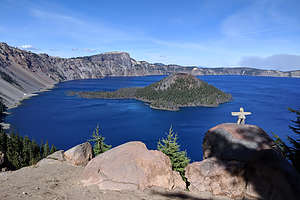 View of Crater Lake and Wizard Island from the Discovery Point TrailAs much as I liked the solitude and remoteness of where we had been so far, I was definitely ready to transition back into civilization. To speed up the process, I suggested we have lunch at the Crater Lake Lodge, a fine example of the rustic and cozy national park lodges I have come to love. It was lovely. The food was delicious and our window table provided us with a view out over the lake.
View of Crater Lake and Wizard Island from the Discovery Point TrailAs much as I liked the solitude and remoteness of where we had been so far, I was definitely ready to transition back into civilization. To speed up the process, I suggested we have lunch at the Crater Lake Lodge, a fine example of the rustic and cozy national park lodges I have come to love. It was lovely. The food was delicious and our window table provided us with a view out over the lake.
Crater Lake is up there on my list of most beautiful lakes in the U.S., along with Lake Tahoe and Lake Powell. It is also the most interesting geologically.
The first thing to realize is that Crater Lake is actually a misnomer, as it more accurately should be called Caldera Lake. For millions of years, there was a huge mountain here called Mount Mazuma. Then, around 7,500 years ago, the mountain erupted, spewing out so much pumice and ash that the summit collapsed, creating a giant caldera, measuring 4,000 feet deep and 6 miles across. That giant caldera was eventually filled in with rainwater and snowmelt, creating the lake, which is somewhat incorrectly called Crater Lake.
Smaller eruptions continued after Mount Mazuma blew, building several cinder cones within the caldera, including Wizard Island, which is the only one tall enough to be exposed today. During one of our previous visits we took a ferry out to it and climbed down into its crater -,an awesome experience that I highly recommend.
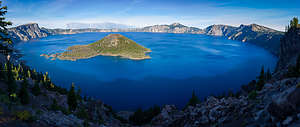 View of Crater Lake and Wizard Island from atop Watchman PeakThe lake is amazingly clear and is an intense sapphire blue in the deep parts and a lovely turquoise and aquamarine along its shallows. The reason it has such a deep blue hue is its depth and purity. It is the deepest lake in the U.S., measuring 1,943 feet at its deepest point. Because it is so deep, when sunlight hits the lake, the longer red waves are absorbed and the deeper violet and blue waves are reflected, causing its deep blue intensity.
View of Crater Lake and Wizard Island from atop Watchman PeakThe lake is amazingly clear and is an intense sapphire blue in the deep parts and a lovely turquoise and aquamarine along its shallows. The reason it has such a deep blue hue is its depth and purity. It is the deepest lake in the U.S., measuring 1,943 feet at its deepest point. Because it is so deep, when sunlight hits the lake, the longer red waves are absorbed and the deeper violet and blue waves are reflected, causing its deep blue intensity.
Our objective for this trip to Crater Lake was to photograph moonrise over Wizard Island, so we spent the afternoon searching for the perfect vantage point - a spot where Wizard Island would not blend into the background of the other shore, but be totally surrounded by water, including its top, and the position of the moonrise would be over Wizard Island. Herb had an app on his phone that would show him exactly where the moon would rise,
We started that search with a walk from the Crater Lake Lodge 2 miles (each way) along the rim on the Discovery Point Trail, to the Discovery Point Lookout. The views were incredible, but the top of Wizard Island still blended into the mountains along the far shoreline and Herb’s app showed that the moon would rise too far to the right of Wizard Island. Close, but no cigar.
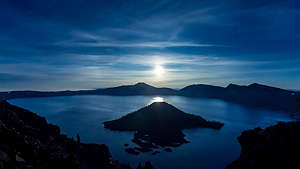 Full moon rising over Crater LakeNext we drove to the Watchman Lookout a few miles beyond Discovery Point. Now this looked promising. Wizard Island was positioned correctly with water showing all around it, and Herb’s app showed the moon rising pretty much right over it. Bingo! Now we just had to wait until moonrise at 7:37 pm.
Full moon rising over Crater LakeNext we drove to the Watchman Lookout a few miles beyond Discovery Point. Now this looked promising. Wizard Island was positioned correctly with water showing all around it, and Herb’s app showed the moon rising pretty much right over it. Bingo! Now we just had to wait until moonrise at 7:37 pm.
We passed the time by hiking the Watchman Peak Trail 1.6 miles (out and back) from the south end of the parking area up a series of switchbacks to the Watchman Fire tower and panoramic views of the lake. We weren’t the only ones with this idea as on our way down we passed a group of about 20 people on a ranger-led hike to the fire tower.
Still an hour to go, so we had some wine and cheese out of the back of the truck. Having a refrigerator in there sure was handy.
Around 7:30, Herb positioned his tripod in what he felt to be the be the best vantage point. We were not the only ones out here with the same idea in mind, and gradually more and more tripods began filling in along the wall above the lake.
It had gotten quite chilly after sunset, so I spent a good deal of my time running back and forth between Herb and the warmth of the truck.
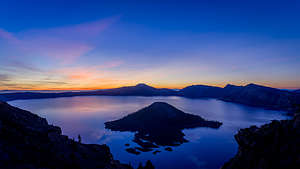 Sunrise over Crater LakeIt was pretty hard to get a photo with a cell phone without a tripod, but I balanced mine on a rock and did my best - lots of cropping and straightening out were needed afterwards. Herb’s photos came out a lot better in terms of composition and being in focus.
Sunrise over Crater LakeIt was pretty hard to get a photo with a cell phone without a tripod, but I balanced mine on a rock and did my best - lots of cropping and straightening out were needed afterwards. Herb’s photos came out a lot better in terms of composition and being in focus.
The evening was so magical that we came back the next morning in time for sunrise at 6:46 am. It was even colder than the night before.
Herb felt vindicated in his selection of a vantage point from which to photograph the sunrise, as he was joined by a professional photographer, who had done even more research than Herb, and come to the same conclusion that this was the place.
I don’t see many sunrises, as I am not much of a morning person, but this experience was enough to make even me a believer in early rising.
Description
Crater Lake is the only national park that is located within a dormant volcano. More than 7,500 years ago, Mount Mazama erupted, spewing out so much pumice and ash that the summit collapsed, creating a giant caldera, measuring 4,000 feet deep and 6 miles across. A series of smaller eruptions afterwards formed several cinder cones on the caldera floor, the largest of which is 2,700-foot high Wizard Island.
Over the next 700 years or so, rain and snowmelt filled the caldera creating what is now the deepest lake in the United States. It is 1,943 feet deep at its deepest point.
Wizard Island is the only cinder cone tall enough to be exposed, rising 755 feet above the current lake level. The top of the Wizard Island cone is capped by a crater about 100 feet deep and 500 feet wide. In fact, this is the only crater in Crater Lake National Park. The lake itself should more accurately be named Caldera Lake.
It is Crater Lake’s extreme depth and purity that gives it its clarity and magnificent deep blue color. As sunlight penetrates the lake, the water molecules absorb the longer red waves in the spectrum and reflect the shorter violet and blue waves, giving its intense deep blue hue.
Crater Lake has no streams flowing into or out of it. It is refilled entirely from rain and snowmelt and is lost through evaporation and subsurface seepage. As a result, the lake had no fish in it until rainbow trout and kokanee salmon were introduced by humans from 1888 to 1941.
If you only have a day to visit the park, the best way to see it is to drive the 33-mile Rim Drive, which encircles the entire lake, stopping at its many overlooks. Because of heavy snowfalls, the Drive is generally open from July to October, and partially open in May, June, and November.
A good place to start the drive is at the Rim Village Visitor Center at the southern end of the lake, where you can stroll out to the Sinnott Memorial Overlook for a spectacular view of the lake and Wizard Island.
The best way to do the Rim Drive is clockwise, so that you can most easily pull into the scenic viewpoints on the lake side of the road. There are 25 of them, so it is very easy to spend a half-day enjoying the drive. My favorites are the overlook at mile 4, which offers an excellent view of Wizard Island, rising 755 above the lake’s surface, and the Phantom Rock Overlook at mile 23.2.
If you have more time, a boat trip out on the lake is definitely worthwhile. Tours are offered from late July to mid-September and in 2013. There are two types of cruises offered. The Standard Tour leaves 6 times a day and costs $35 for an adult. It does not stop at Wizard Island. The Wizard Island Tour only leaves twice a day (9:30 and 12:30) and costs $45 for an adult. This tour drops people off and allows them to hike and explore the island for 3 hours before the boat returns to bring you back. Each tour has a park ranger aboard to discuss the geology and natural history of Crater Lake. Tickets sell out quickly, so be sure to buy them in advance at the kiosk in the Crater Lake Lodge. I definitely recommend the Wizard Lake Tour.
To get to the boat, park at the Cleetwood Cove Trailhead on the north side of the lake, and hike the steep 1 mile trail down to the lakeshore. This trail provides the only access to the lake. Before committing to the trek down, make sure you feel comfortable with the strenuous climb back up.
Once you reach the lakeshore, you are sure to see dozens of people jumping from a high rock into the chilly waters of the lake.
Once on Wizard Island, there are two hiking options. The most popular is the relatively steep 0.9 mile trek (each way) up the steep Wizard Island Summit Trail. Besides the wonderful views of the lake along the way, once on top of the cinder cone, you can descend into 100-feet deep crater.
The other option is to hike along the rough volcanic rock along the shore to Fumarole Bay – about 0.7 miles each way. There is an excellent view from here of Watchman Peak, straight across the lake. The shallow, clear water in the bay is good for swimming (chilly) and fishing for rainbow trout and kokanee salmon. Unlicensed fishing is allowed in the park without any limitation of size, species, or number. In fact, the park encourages fishing to try to rid the lake of these non-indigenous fish.
In addition to the Cleetwood Cove and Wizard Island trails, there are several other hiking options in the park. These include:
- 3.5 mile (round trip) steep hike to Garfield Peak, with tremendous views after ½ mile of hiking. The trail starts from the parking lot of Crater Lake Lodge
- 1.7 mile (round trip) Annie Creek Canyon Trail, which begins behind the amphitheater at the Mazama Campground and loops down to the bottom of a deep, stream-cut canyon and back.
- 3.9 mile (round trip) hike to the summit of Mt. Scott, the highest point in the park, with panoramic views of the lake and Klamatch Basin.
- 0.7 mile (round trip) Pinnacles hike through dramatic tall pinnacles and spires. The trailhead is located on the Pinnacles Spur Road, 7 miles southeast of the Phantom Ship Overlook in the southeast corner of the park.
The park has two campgrounds:
- The Lost Creek campground is tent only and is open from mid-July to late September. This campground is located on the Pinnacles Spur Road in the southeast corner of the park.
- The Mazama Campground has 213 tent and RV sites (and some hookups) and is open from late June to mid October. This campground is located in Mazama Village, about 3 miles south of the Steel Visitor Center
- ‹ previous
- 7 of 9
- next ›
Crater Lake National Park location map in "high definition"
Javascript is required to view this map.
